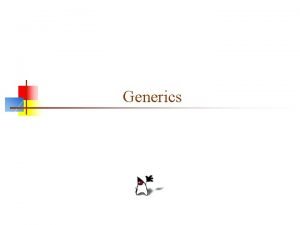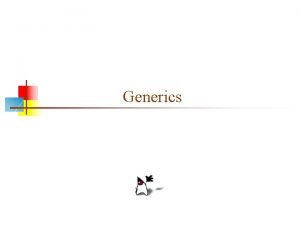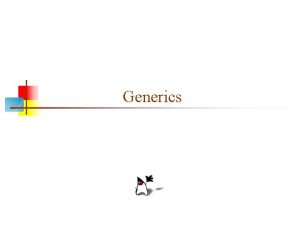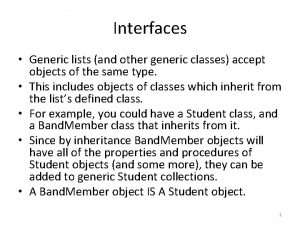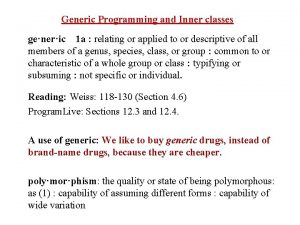Generics Contents Introduction Benefits of Generics Generic Classes

Generics

Contents Introduction Benefits of Generics Generic Classes and Interfaces Generic Methods Wildcard Generic Types Restrictions on Generics

Introduction Enables to create classes, interfaces, and methods in which the type of data upon which they operate is specified as a parameter. Introduced in Java by jdk 1. 5. Generics means parameterized types. Generics add the type-safety. Generics add stability to your code by making more of your bugs detectable at compile time.

Why Generics? The functionality of Gen class can be achieved without generics by specifying Object type and using proper casting whenever required. Then why we use Generics? Java compiler does not have knowledge about the type of data actually stored in Non. Gen. So: Explicit casts must be employed to retrieve the stored data. Several type mismatch errors cannot be found until run time.

Why Generics? Stronger type checks at compile time Elimination of casts Array. List list = new Array. List(); list. add("hello"); String s = (String) list. get(0); Using generics: List<String> list = new Array. List<String>(); list. add("hello"); String s = list. get(0); // no cast Enabling programmers to implement generic algorithms. We can implement generic algorithms that work on collections of different types, can be customized, and are type safe and easier to read.

Advantage of Generics The ability to create type-safe code in which type-mismatch errors are caught at compile time is a key advantage of generics.

Example

Generics Work Only with Objects When declaring an instance of a generic type, the type argument passed to the type parameter must be a class type. Gen<int> str. Ob = new Gen<int>(53); The above declaration is an error. A reference of one specific version of a generic type is not type compatible with another version of the same generic type. i. Ob = str. Ob; // Wrong!

Generic Class

General Form of Generic Class The generics syntax for declaring a generic class: class-name<type-param-list> { //. . . } The syntax for declaring a reference to a generic class: class-name<type-arg-list> var-name = new class-name<type-arg-list>(cons-arg-list);

Generic Class with Multiple Type Parameters

Problem Create a generic class that contains a method that returns the average of an array of numbers of any type, including integers, floats, and doubles.

Possible Solution

Why Error? The compiler has no way to know that you are intending to create Gen class objects using only numeric types. When we try to compile Gen class, an error is reported that indicates that the double. Value( ) method is unknown. We need some way to tell the compiler that we intend to pass only numeric types to T.

Bounded Types Used to limit the types that can be passed to a type parameter. When specifying a type parameter, we can create an upper bound that declares the super-class from which all type arguments must be derived. <T extends superclass> A bound can include both a class type and one or more interfaces. class Gen<T extends My. Class & My. Interface> Any type argument passed to T must be a subclass of My. Class and implement My. Interface.

Solution

WILD CARD Generic. S

Example (comparing object values) method compare(Stats<Integer>) in the type Gen<Integer> is not applicable for the arguments (Gen<Double>)

Memory representation of objects Gen<Integer> obj 1 Object of Gen<Integer> required Gen<Double> obj 2

Solution wildcard generic (i. e. it accepts any type)

Problem Create a generic class Stats that contains a method same. Avg( ) that determines whether two different Stats class objects contain arrays that yield the same average or not; no matter what type of numeric data each object holds. For example, if one object contains the double values 1. 0, 2. 0, and 3. 0, and the other object contains the integer values 2, 1, and 3, then the averages will be the same.

Possible Solution method same_Avg(Stats<Integer>) in the type Stats<Integer> is not applicable for the arguments (Stats<Double>)

Why Error? It will work only with the objects of same type. if the invoking object is of type Stats<Integer>, then the parameter ob must also be of type Stats<Integer>.

Wild. Card Argument The wildcard simply matches the validity of object. The wildcard argument is specified by the ? , and it represents an unknown type. boolean same_Avg(Stats<? > ob) { if(average() == ob. average()) return true; return false; } Important: It is important to understand that the wildcard does not affect what type of Stats class objects can be created. This is governed by the extends clause in the Stats class declaration. The wildcard simply matches any valid Stats class object.

Bounded Wildcards A bounded wildcard is especially important when you are creating a generic type that will operate on a class hierarchy. // Two-dimensional coordinates. class Two. D { int x, y; Two. D(int a, int b) { x = a; y = b; } }

Bounded Wildcards // Three-dimensional coordinates. class Three. D extends Two. D { int z; Three. D(int a, int b, int c) { super(a, b); z = c; } } // Four-dimensional coordinates. class Four. D extends Three. D { int t; Four. D(int a, int b, int c, int d) { super(a, b, c); t = d; } }

Bounded Wildcards // This class holds an array of coordinate objects. class Coords<T extends Two. D> { T[] coords; Coords(T[] o) { coords = o; } } Ø Notice that Coords specifies a type parameter bounded by Two. D. static void show. XY(Coords<? > c) { System. out. println("X Y Coordinates: "); for(int i=0; i < c. coords. length; i++) System. out. println(c. coords[i]. x + " " + c. coords[i]. y); System. out. println(); }

Bounded Wildcards Problem Starts if I want to create a methods show. XYZ() for Three. D and Four. D Object. static void show. XYZ(Coords<? extends Three. D> c) { System. out. println("X Y Z Coordinates: "); for(int i=0; i < c. coords. length; i++) System. out. println(c. coords[i]. x + " " + c. coords[i]. y + " " + c. coords[i]. z); System. out. println(); }

Generic Method

Generic Method It is possible to declare a generic method that uses one or more type parameters. Methods inside a generic class are automatically generic relative to the type parameters. It is possible to create a generic method that is enclosed within a nongeneric class.

Generic Methods The type parameters are declared before the return type of the method. Generic methods can be either static or non-static. <type-param-list> ret-type method-name(param-list) {…} Example: static <T, V extends T> boolean is. In (T x, V[] y) This ability to enforce type safety is one of the most important advantages of generic methods.

Example

Generic Interfaces

Generic Interfaces Generic interfaces are specified just like generic classes.

Generic Interfaces Generic interfaces are specified just like generic classes. Example: interface Min. Max<T extends Comparable<T>> { T min(); T max(); } The implementing class must specify the same bound. Once the bound has been established, it need not to be specified again in the implements clause.

class My. Class<T extends Comparable<T>> implements Min. Max <T extends Comparable<T>> { //Wrong In general, if a class implements a generic interface, then that class must also be generic, at least to the extent that it takes a type parameter that is passed to the interface. For example, the following attempt to declare My. Class is in error: class My. Class implements Min. Max<T> { // Wrong! Because My. Class does not declare a type parameter, there is no way to pass one to Min. Max. In this case, the identifier T is simply unknown, and the compiler reports an error. Of course, if a class implements a specific type of generic interface, such as shown here: class My. Class implements Min. Max<Integer> { // OK

Generic Interface interface Min. Max<T extends Comparable<T>> { T min(); T max(); } class Myclass<T extends Comparable<T>> implements Min. Max<T> { … }

Example

Generic Constructors

Generic Constructors It is possible for constructors to be generic, even if their class is not. Example: class Gen. Cons { private double val; <T extends Number> Gen. Cons(T arg) { val = arg. double. Value(); } void show_val() { System. out. println("val: " + val); } }

Erasure // Here, T is bound by Object by default. class Gen<T> { T ob; // here, T will be replaced by Object Gen(T o) { ob = o; } // Return ob. T getob() { return ob; } } // Here, T is bound by String. class Gen. Str<T extends String> { T str; // here, T will be replaced by String Gen. Str(T o) { str = o; T getstr() { return str; } } }

erasure class Gen extends java. lang. Object{ java. lang. Object ob; Gen(java. lang. Object); java. lang. Object getob(); } class Gen. Str extends java. lang. Object{ java. lang. String str; Gen. Str(java. lang. String); java. lang. String getstr(); }

Some Generic Restrictions Type Parameters Can’t Be Instantiated // Can't create an instance of T. class Gen<T> { T ob; Gen() { ob = new T(); // Illegal!!! } }

Some Generic Restrictions on Static Members class Wrong<T> { // Wrong, no static variables of type T. static T ob; // Wrong, no static method can use T. static T getob() { return ob; }
![Some Generic Restrictions Generic Array Restrictions // vals = new T[10]; // can't create Some Generic Restrictions Generic Array Restrictions // vals = new T[10]; // can't create](http://slidetodoc.com/presentation_image/43a39962ca37101beba2e65d4ff1fa22/image-45.jpg)
Some Generic Restrictions Generic Array Restrictions // vals = new T[10]; // can't create an array of T // Gen<Integer> gens[] = new Gen<Integer>[10]; // Wrong! it’s valid to declare a reference to an array of type. cannot create generic exception classes. Cannot Instantiate Generic Types with Primitive Types Pair<int, char> p = new Pair<>(8, 'a'); Cannot Create, Catch, or Throw Objects of Parameterized Types

- Slides: 46



